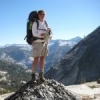I'm afraid I have to balance current reports with historic aboriginal accounts, other mammilian densities and histories of abundance/scarcities, and human population explosions. Yes, coyotes populations can even increase alongside human population explosions, cougars can survive alongside such human population explosions, and feral hogs can literally take over rural areas as humans proliferate, but grizzly bears cannot do any of that.
Aboriginal accounts universally indicate sasquatches inhabiting the most rugged terrain and only occasionally raiding human villages. Accepting all current reports and thus theorizing that there are 50,000 or more sasquatches running around the continent is to make the failure of discovery that much more fantastic and unlikely. As I posted above, the population density of black bears in Florida is a third of what it was in 1500. Cougars are critically endangered there. The human population of Florida in 1900 was 528,000. Today, 120 years later, it is over 21 million, an increase of 4000%.
It is not unreasonable to expect fewer sasquatches, and it is very reasonable to see that there are over 40 times as many people today to see the few sasquatches remaining.
This fits the Glickman theory of sighting densities (pages 2-7):
http://www.photekimaging.com/Support/rptcol2.pdf



